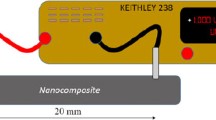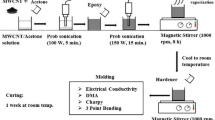Abstract
In the present work, the conductivity of multi-walled carbon nanotube (MWCNT) and epoxy resin matrix nanocomposites produced under the action of a 100-V/cm external sinusoidal electric field is studied, for five MWCNT concentration values. The results showed that the AC electrical conductivities of the nanocomposite samples exhibited a large increase compared to those of pure epoxy resin samples. The conductivity at 40 Hz increased from ~ 10−9 S/m for the pure resin samples to 10−2–10−3 S/m for materials with 0.30 wt% MWCNT concentration, while a further increase of up to ~ 10−1 S/m was achieved on the samples produced under the effects of a sinusoidal field. This phenomenon was attributed to a spatial alignment of the MWCNT inside the epoxy matrix and/or the bending of close MWCNT due to the electrostatic force, which created efficient electric current conduction paths along the MWCNT. A proposed new method estimated the value of the current percolation threshold, yielding a result of 0.016 wt% for the sample that was not subjected to the electric field, which then decreased by approximately one order of magnitude for the samples subjected to the electric field.





Similar content being viewed by others
References
J.-H. Du, J. Bai, H.-M. Cheng, The present status and key problems of carbon nanotube based polymer composites. Express. Polym. Lett. 1, 253–273 (2007)
S. H. Pezzin, S. C. Amico, L. A. F. Coelho, M. J. Andrade, nanoreinforcements for nanocomposite materials, vol. 1 (Springer-Verlag Berlin Heidelberg, 2011), pp. 119–131
E. Thostenson, C. Li, T. Chou, Nanocomposites in context. Compos. Sci. Technol. 65, 491–516 (2005)
S. Iijima, Helical microtubes of graphitic carbon. Letters. Nat. 354, 56–58 (1991)
E. Logakis, C. Pandis, P. Pissis, J. Pionteck, P. Pötschke, Highly conducting poly(methyl methacrylate)/carbon nanotubes composites: investigation on their thermal, dynamic-mechanical, electrical and dielectric properties. Compos. Sci. Technol. 71, 854–862 (2011)
J. Sandler, M.S.P. Shaffer, T. Prasse et al., Development of a dispersion process for carbon nanotubes in an epoxy matrix and the resulting electrical properties. Polymer 40, 5967–5971 (1999)
X.-L. Xie, Y.-W. Mai, X.-P. Zhou, Dispersion and alignment of carbon nanotubes in polymer matrix: a review. Materials science and engineering: R: reports, 49 (2005), pp. 89–112
Q. Wang, J. Dai, W. Li, Z. Wei, J. Jiang, The effects of CNT alignment on electrical conductivity and mechanical properties of SWNT/epoxy nanocomposites. Compos. Sci. Technol. 68, 1644–1648 (2008)
J. Gao, D. Yan, B. Yuan, H. Huang, Z. Li, Large-scale fabrication and electrical properties of an anisotropic conductive polymer composite utilizing preferable location of carbon nanotubes in a polymer blend. Compos. Sci. Technol. 70, 1973–1979 (2010)
T. Kim, A. Tannenbaum, R. Tannenbaum, Anisotropic conductivity of magnetic carbon nanotubes embedded in epoxy matrices. Carbon. N. Y. 70, 54–61 (2011)
B.W. Steinert, D.R. Dean, Magnetic field alignment and electrical properties of solution cast PET–carbon nanotube composite films. Polymer 50, 898–904 (2009)
C. Martin, J. Sandler, A. Windle et al., Electric field-induced aligned multi-wall carbon nanotube networks in epoxy composites. Polymer 46, 877–886 (2005)
H. Pang, C. Chen, Y. Zhang, P. Ren, D. Yan, Z.-M. Li, The effect of electric field, annealing temperature and filler loading on the percolation threshold of polystyrene containing carbon nanotubes and graphene nanosheets. Carbon 49, 1980–1988 (2011)
H. Yurdakul, A.T. Seyhan, S. Turan, M. Tanoglu, W. Bauhofer, K. Schulte, Electric field effects on CNTs/vinyl ester suspensions and the resulting electrical and thermal composite properties. Compos. Sci. Technol. 70, 2102–2110 (2010)
Y.-F. Zhu, C. Ma, W. Zhang et al., Alignment of multiwall carbon nanotubes in bulk epoxy composites via electric field. J. Appl. Phys. 105, 543191–543196 (2009)
C. K. Kwan. Dielectric phenomena in solids (Elsevier, New York, 2004)
A. Batisti, A. Skordos, I.K. Partridge, Percolation threshold of carbon nanotubes filled unsaturated polyesters. Compos. Sci. Technol. 70, 633–637 (2010)
C.A. Martina, J.K.W. Sandler, M.S.P. Shaffer, M.-K. Schwarz, W. Bauhofer, K. Schulted, A.H. Windla, Formation of percolating networks in multi-wall carbon-nanotube–epoxy. composites 64, 2309–2316 (2004)
R. Zallen, The physics of amorphous solids (John Willey and Sons, New York, 1983)
Z. Spitalski, D. Tassis, K. Papagelis, C. Galiotis, Carbon nanotube–polymer composites: chemistry, processing, mechanical and electrical properties. Prog. Polym. Sci. 35, 357–401 (2010)
Acknowledgments
The authors would like to thank Profs. I. A. Hümmelgen and C. K. Saul for the use of their laboratory facilities, CAPES (Brazilian Funding Agency), and the CME-UFPR (Centro de Microscopia Eletrônica).
Author information
Authors and Affiliations
Corresponding author
Rights and permissions
About this article
Cite this article
Hattenhauer, I., Tambosi, P.P., Duarte, C.A. et al. Impact of Electric Field Application During Curing on Epoxy-Carbon Nanotube Nanocomposite Electrical Conductivity. J Inorg Organomet Polym 25, 627–634 (2015). https://doi.org/10.1007/s10904-014-0125-x
Received:
Accepted:
Published:
Issue Date:
DOI: https://doi.org/10.1007/s10904-014-0125-x




